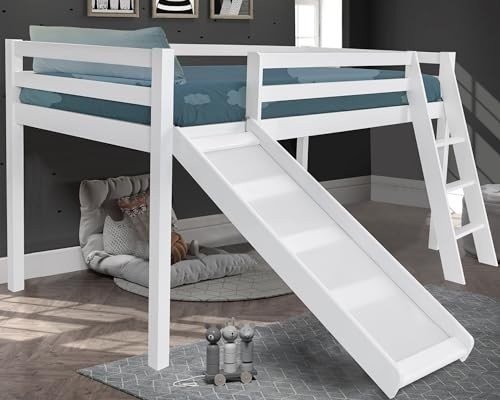The Ultimate Guide to Bunk Beds for Children: Safety, Styles, and Benefits
When it comes to styling a child's room, moms and dads typically face the double obstacle of making the most of space while ensuring convenience and functionality. Bunk beds have actually become a popular option that resolves these needs, offering not just sleeping plans but also contributing to a space's visual. In rhianna.top , we will look into various elements of kids's bunk beds, focusing on their benefits, security features, styles, and factors to consider for parents considering this purchase.
Table of Contents
- Advantages of Bunk Beds
- Security Features to Consider
- Kinds Of Bunk Beds
- Design and Style Options
- Maintenance Tips
- Often Asked Questions (FAQs)
1. Benefits of Bunk Beds
Bunk beds provide many advantages for children and their parents. Here are some essential advantages:
- Space-Efficiency: Bunk beds are an outstanding service for smaller rooms. By stacking one bed on top of another, more floor space is offered for play, storage, or study locations.
- Cost-Effective: When children share rooms, bunk beds can decrease the need for acquiring 2 separate beds, thus saving cash.
- Promotes Social Interaction: Bunk beds can help siblings or good friends bond by sharing a space, developing chances for social advancement.
- Enjoyable Factor: The concept of sleeping "up high" includes a spirited aspect to bedtime, making the shift to sleeping alone simpler for some children.
- Versatile Design: Bunk beds can be found in different styles, colors, and develops to match any space style, allowing for modification that shows the kid's personality.
2. Safety Features to Consider
Safety is vital when it concerns kids's furnishings, especially when it comes to bunk beds. Here are some vital security functions to assess:
| Safety Feature | Description |
|---|---|
| Tough Construction | Frames made of strong wood or metal are chosen. |
| Guardrails | Must be at least 5 inches high and extend along both sides of the upper bunk. |
| Ladder Design | Ensure ladders are firmly attached and have non-slip steps. |
| Bed mattress Size & & Fit | Must fit snugly within the frame to prevent spaces. |
| Weight Limit | Constantly abide by the manufacturer's weight limitation recommendations. |
3. Types of Bunk Beds
Bunk beds can be found in a number of styles, catering to different needs, choices, and space sizes. Here are some typical types:
- Standard Bunk Bed: The many basic type, with one bed on top of another.
- Loft Bed: Features a high upper bed with space beneath for a desk or play area.
- Futon Bunk Bed: Combines a leading bunk with a futon on the bottom, offering flexibility for seating and sleeping.
- L-Shaped Bunk Bed: This design has the top bunk set at a perpendicular angle to the bottom, producing a small corner area.
- Triple Bunk Bed: Accommodates 3 kids utilizing stacked beds, suitable for big households or sleepovers.
4. Style and Style Options
When it comes to choosing a style for children's bunk beds, the options are virtually limitless. Here are some popular designs:
- Traditional Style: Often made of wood, these bunk beds include elaborate details and are ideal for timeless or rustic-themed spaces.
- Modern Style: Characterized by clean lines and minimalist styles, contemporary bunk beds can be made of metal or wood.
- Themed Bunk Beds: Some brands provide bunk beds shaped like castles, cars, or playhouses, making bedtime less of a chore.
- Convertible Bunk Beds: These can be separated into 2 private beds, providing flexibility as kids grow.
- Colorful Options: Bunk beds in vibrant colors can include a sense of pleasure and playfulness to any space.
5. Upkeep Tips
Maintaining a bunk bed is crucial for durability and security. Here are some suggestions:
- Regular Inspections: Check for loose screws or bolts every few months and tighten them as required.
- Cleaning: Wipe down frames routinely to avoid dust accumulation; think about using a vacuum for hard-to-reach areas.
- Bed mattress Care: Rotate bed mattress routinely and use protective covers to extend their life.
- View for Wear and Tear: Look for any signs of damage in the wood or metal and think about changing parts if required.
- Teach Kids Safety Rules: Encourage children to use ladders effectively and ensure they understand the security features of their bed.
6. Regularly Asked Questions (FAQs)
Q1: What age is proper for oversleeping a leading bunk?
A1: Typically, children aged 6 and older are recommended for upper bunk sleeping, as they have the essential motor abilities to climb up securely.
Q2: Do bunk beds feature a mattress?
A2: Most bunk beds are sold as frames just, so you will require to purchase bed mattress separately. Guarantee that the mattress fits the frame snugly.
Q3: Can bunk beds be separated later on?
A3: Many styles allow conversion into two specific beds, offering versatility for future requirements.
Q4: How can I guarantee my child's security on a bunk bed?
A4: Comply with security requirements and make sure guardrails, a tough frame, and a secured ladder remain in place.
Q5: Are there weight limitations on bunk beds?
A5: Yes, constantly inspect the manufacturer's requirements relating to weight limitations to guarantee security.
Bunk beds for children can serve multiple functions while ensuring safety and style. With varied styles and designs available on the market, moms and dads can find a system that not only takes full advantage of bed room space but also reflects their child's special tastes. Just like any furniture, comprehending safety features, upkeep, and how they fit into a kid's lifestyle will guarantee that these beds remain a useful furniture option for several years to come.
Through careful consideration and adherence to security guidelines, bunk beds can supply a long-lasting, fun, and functional sleeping solution that kids enjoy.

